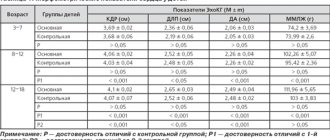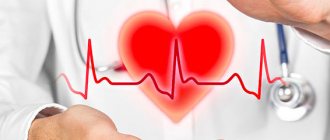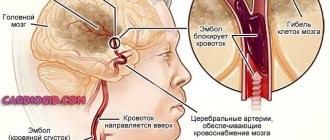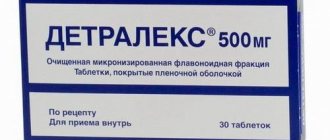ECG technique: algorithm
Immediately before the scheduled registration of an ECG, the patient should not eat, smoke, drink stimulating drinks (tea, coffee, energy drinks), or exert any physical stress on the body.
We record in the necessary documentation the patient’s personal data, medical history number, date and time of the ECG.
We place the patient on the couch in a supine position. We degrease those areas of the skin where we will apply the electrodes - wipe them with a napkin soaked in an isotonic solution of sodium chloride (0.9%). We apply electrodes: 4 plate electrodes - on the lower thirds of the inner surface of the legs and forearms, and on the chest - chest electrodes equipped with suction cups. For single-channel recording, 1 chest electrode is used, for multi-channel recording, several are used.
We connect wires of a certain color coming from the electrocardiograph to each electrode.
Common markings for electrocardiograph wires:
- red - right hand;
- yellow - left hand;
- green - left leg;
- black - right leg (patient grounding);
- white - chest electrode.
When recording an ECG in 6 chest leads in the presence of a six-channel electrocardiograph, use the following tip markings:
- red - for connection to electrode V1;
- yellow - to V2;
- green to V3;
- brown - to V4;
- black - to V5;
- blue or purple - to V6.
Most often, the ECG is recorded in 12 leads:
- standard (bipolar) leads (I, II, III);
- 3 reinforced unipolar leads;
- 6 chest leads.
Standard (bipolar) ECG leads
Registration of standard limb leads is carried out by connecting electrodes in pairs:
- I standard lead - left hand (+) and right hand (-);
- II standard lead - left leg (+) and right arm (-);
- III standard lead - left leg (+) and left leg (-).
Electrodes are applied to the left arm, right arm and left leg (see markings in the figure). A 4th electrode is placed on the right leg to connect to the ground wire.
Formation of three standard electrocardiographic leads from the limbs. Below is Einthoven’s triangle, each side of which is the axis of one or another standard lead
Reinforced unipolar limb leads
Unipolar leads are characterized by the presence of only one active - positive - electrode, the negative electrode is indifferent and represents a “combined Golberg electrode”, which is formed when two limbs are connected through additional resistance.
Reinforced unipolar leads have the following designations:
- aVR—right arm abduction;
- aVL - from the left hand;
- aVF - from the left leg.
Formation of three reinforced unipolar limb leads. Below is Einthoven’s triangle and the location of the axes of three reinforced unipolar limb leads.
Chest leads
The chest leads in the ECG are unipolar. The active electrode is connected to the positive pole of the electrocardiograph, and the triple indifferent electrode combined from the limbs is connected to the negative pole of the device. The chest leads are usually designated by the letter V:
- V1 - the active electrode is placed in the IV intercostal space at the right edge of the sternum;
- V2 - in the IV intercostal space at the left edge of the sternum;
- V3 - between the IV and V intercostal spaces along the left parasternal line;
- V4 - in the 5th intercostal space along the left midclavicular line;
- V5 - in the 5th intercostal space along the anterior axillary line;
- V6 - and V intercostal space along the midaxillary line.
Selecting the electrocardiograph gain
When selecting the gain of each channel of the electrocardiograph, it is necessary that a voltage of 1 mV causes a deflection of the galvanometer and recording system of 10 mm. In the “0” position of the lead switch, the gain of the device is adjusted and the calibration millivolt is recorded. If the amplitude of the teeth is too large (1 mV = 5 mm), you can reduce the gain; if it is small (1 mV = 15-20 mm), you can increase it.
ECG registration
An electrocardiogram is recorded while the patient is breathing quietly. First - in standard leads I, II, III, then - in reinforced unipolar leads from the limbs (aVR, aVL, aVF), then - in chest leads V1. V2, V3, V4, V5, V6. At least 4 cardiac cycles should be recorded in each lead.
As can be concluded from the above, with the necessary knowledge and skills, the technique of taking an ECG should not present any difficulties for the nurse.
What concepts are used when decoding
Decoding an ECG is a rather complex process that requires deep knowledge from a specialist. During the assessment of the heart condition, the cardiogram parameters are measured mathematically. In this case, concepts such as sinus rhythm, heart rate, electrical conductivity and electrical axis, pacemakers and some others are used. By assessing these indicators, the doctor can clearly determine some parameters of the functioning of the heart.
Heart rate
Heart rate is a specific number of heart beats over a certain period of time. Typically an interval of 60 seconds is taken. On a cardiogram, heart rate is determined by measuring the distance between the tallest teeth (R - R). The recording speed of the graphic curve is usually 100 mm/s. By multiplying the recording length of one mm by the duration of the segment R – R, the heart rate is calculated. In a healthy person, the heart rate should be 60 - 80 beats per minute.
Sinus rhythm
Another concept included in the interpretation of the ECG is the sinus rhythm of the heart. During normal functioning of the heart muscle, electrical impulses arise in a special node, then spread to the area of the ventricle and atrium. The presence of sinus rhythm indicates normal functioning of the heart.
The cardiogram of a healthy person should show the same distance between the R waves throughout the entire recording. A deviation of 10% is allowed. Such indicators indicate the absence of arrhythmia in a person.
Conduction Paths
This concept defines a process such as the propagation of electrical impulses through the tissues of the heart muscle. Normally, impulses are transmitted in a certain sequence. Violation of the order of their transfer from one pacemaker to another indicates organ dysfunction and the development of various blockades. These include sinoatrial, intraatrial, atrioventricular, intraventricular blocks, as well as Wolff-Parkinson-White syndrome.
On an ECG, a specialist can see a violation of cardiac conduction
Electrical axis of the heart
When deciphering a cardiogram of the heart, the concept of the electrical axis of the heart is taken into account. This term is widely used in cardiological practice. When interpreting an ECG, this concept allows a specialist to see what is happening in the heart. In other words, the electrical axis is the totality of all biological and electrical changes within an organ.
An electrocardiogram allows you to visualize what is happening in a specific area of the heart muscle using a graphic image obtained by transmitting impulses from electrodes to a special device.
The position of the electrical axis is determined by the doctor using special diagrams and tables or by comparing the QRS complexes, which are responsible for the process of excitation and contraction of the cardiac ventricles.
If ECG indicators indicate that the R wave in lead III has a smaller amplitude than in lead I, we are talking about a deviation of the cardiac axis to the left. If in lead III the R wave has a greater amplitude than in lead I, it is customary to speak of axis deviation to the right. Normal indicators in the cardiogram table are the highest R wave in lead II.
Teeth and intervals
On the cardiogram itself obtained during the study, the waves and intervals are not indicated. They are needed only for the specialist doing the decryption.
Prongs:
- P – determines the beginning of contraction of the atrium;
- Q, R, S – belong to the same type, coincide with the contraction of the ventricles;
- T – time of inactivity of the ventricles of the heart, that is, their relaxation;
- U - rarely noted on the cardiogram; there is no consensus on its origin.
For ease of interpretation, the cardiogram is divided into intervals. On the tape you can see straight lines that run clearly in the middle of the tooth. They are called isolines or segments. When making a diagnosis, indicators of the P – Q and S – T segments are usually taken into account.
In turn, one interval consists of segments and teeth. The length of the interval also helps assess the overall picture of heart function. The intervals P - Q and Q - T have diagnostic significance.
Important! You cannot read a cardiogram yourself without certain knowledge. Decoding of the cardiogram is carried out exclusively by a specialist.
Reading a cardiogram
How to decipher a cardiogram of the heart? This question is asked by many patients who have had to deal with the electrocardiography procedure. It is very difficult to do this yourself, because decrypting data has a lot of nuances. And if you read certain disturbances in the activity of the heart in your cardiogram, this does not at all mean the presence of this or that disease.
A cardiologist reads a cardiogram
Prongs
In addition to taking into account intervals and segments, it is important to monitor the height and duration of all teeth. If their fluctuations do not deviate from the norm, this indicates healthy functioning of the heart. If the amplitude is deviated, we are talking about pathological conditions.
Norm of waves on an ECG:
- P – should have a duration of no more than 0.11 s., a height within 2 mm. If these indicators are violated, the doctor can make a conclusion about a deviation from the norm;
- Q – should not be higher than a quarter of the R wave, wider than 0.04 s. Particular attention should be paid to this tooth; its deepening often indicates the development of myocardial infarction in a person. In some cases, tooth distortion occurs in people with severe obesity;
- R – when deciphered, it can be traced in leads V5 and V6, its height should not exceed 2.6 mV;
- S is a special tooth for which there are no clear requirements. Its depth depends on many factors, for example, weight, gender, age, body position of the patient, but when the tooth is too deep, we can talk about ventricular hypertrophy;
- T – must be at least a seventh of the R wave.
In some patients, after the T wave on the cardiogram, a U wave appears. This indicator is rarely taken into account when making a diagnosis and does not have any clear standards.
Segments and Intervals
Intervals and segments also have their own normal values. If these values are violated, the specialist usually gives a referral to the person for further research.
Normal indicators:
- The ST segment should normally be located directly on the isoline;
- The QRS complex should not last more than 0.07 - 0.11 s. If these indicators are violated, various pathologies of the heart are usually diagnosed;
- the PQ interval should last from 0.12 milliseconds to 0.21 seconds;
- The QT interval is calculated taking into account the heart rate of a particular patient.
Segments and Intervals
Important! The ST segment in leads V1 and V2 sometimes runs slightly above the baseline. The specialist must take this feature into account when deciphering the ECG.
Decryption features
To record a cardiogram, special sensors are attached to a person’s body, which transmit electrical impulses to an electrocardiograph. In medical practice, these impulses and the paths they take are called leads. Basically, 6 main leads are used during the study. They are designated by the letters V from 1 to 6.
The following rules for deciphering a cardiogram can be distinguished:
- In lead I, II or III, you need to determine the location of the highest region of the R wave, and then measure the gap between the next two waves. This number should be divided by two. This will help determine the regularity of your heart rate. If the gap between the R waves is the same, this indicates normal contraction of the heart.
- After this, you need to measure each tooth and interval. Their standards are described in the article above.
Most modern devices automatically measure your heart rate. When using older models, this has to be done manually. It is important to consider that the ECG recording speed is usually 25 – 50 mm/s.
Heart rate is calculated using a special formula. At an ECG recording speed of 25 mm per second, it is necessary to multiply the R - R interval distance by 0.04. In this case, the interval is indicated in millimeters.
At a speed of 50 mm per second, the R - R interval must be multiplied by 0.02.
For ECG analysis, 6 of 12 leads are usually used, since the next 6 duplicate the previous ones.
Installation of electrodes
Both reusable and disposable electrodes can be used to take an ECG. The first option is used more often in medical institutions, because is more economical. Kit includes:
- electrodes for limbs: 4 pieces;
- electrodes placed on the chest (one or 6);
- pears with suction cups.
Each electrode must be connected to a cable that matches its color. The designations must be memorized, because Most often there is confusion with them.
- A red cable is connected to the electrode on the right hand.
- On the left is yellow.
- The green wire is connected to the electrode on the left leg.
- On the right there will be a black, grounding cable that does not take readings.
Normal values in children and adults
In medical practice, there is the concept of an electrocardiogram norm, which is typical for each age group. Due to the anatomical characteristics of the body in newborns, children and adults, the study indicators are slightly different. Let's take a closer look at them.
ECG norms for adults can be seen in the figure.
Normal ECG in adult patients
A child's body is different from an adult's. Due to the fact that the organs and systems of the newborn are not fully formed, electrocardiography data may differ.
In children, the mass of the right ventricle of the heart prevails over the left ventricle. Newborns often have a high R wave in lead III and a deep S wave in lead I.
The ratio of the P wave to the R wave in adults is normally 1:8; in children, the P wave is tall, often more pointed, in relation to R is 1:3.
Due to the fact that the height of the R wave is directly related to the volume of the ventricles of the heart, its height is lower than in adults.
Indications for ECG
ECG is performed:
- for any diseases of the cardiovascular system;
- if you suspect such diseases, for example, chest pain, shortness of breath, swelling of the legs;
- people who are at risk of developing heart disease (those with a hereditary predisposition, those suffering from obesity, atherosclerosis, bad habits - smoking, alcoholism) to determine the condition of the heart;
- in case of risk of complications from the heart, in particular with hypertension, after infectious diseases (for example, tonsillitis), after a stroke;
- when planning and managing pregnancy;
- to assess the effect of medications on the body (in particular, to confirm the absence of side effects when taking them);
- to check the operation of pacemakers.
What affects the accuracy of indicators
Sometimes the results of a cardiogram may be erroneous and differ from previous studies. Errors in results are often associated with many factors. These include:
- incorrectly attached electrodes. If the sensors are poorly attached or become dislodged during an ECG, the test results can be seriously affected. That is why the patient is recommended to lie still during the entire period of taking the electrocardiogram;
- extraneous background. The accuracy of the results is often influenced by extraneous devices in the room, especially when the ECG is performed at home using mobile equipment;
- smoking, drinking alcohol. These factors affect blood circulation, thereby changing the cardiogram parameters;
- meal. Another reason that affects blood circulation and, accordingly, the correctness of indicators;
- emotional experiences. If the patient is worried during the study, this may affect the heart rate and other indicators;
- Times of Day. When conducting a study at different times of the day, the indicators may also differ.
The specialist must take into account the above-described nuances when interpreting the ECG; if possible, they should be excluded.
When and who needs to undergo heart diagnostics?
The doctor prescribes this diagnostic test in the following cases:
- high blood pressure;
- chest pain, shortness of breath;
- dizziness or fainting;
- heart murmurs;
- heart rhythm is disturbed;
- rheumatism;
- diabetes.
An electrocardiogram is also prescribed in case of overdose of certain medications. An ECG is part of the examination during medical examination, prof. examination, pregnancy, preparation for operations.
This is not an exhaustive list of cases when an ECG is necessary. In addition, it is performed without a doctor’s referral.
Dangerous diagnoses
Diagnostics using electrical cardiography helps to identify many cardiac pathologies in a patient. Among them are arrhythmia, bradycardia, tachycardia and others.
Cardiac conduction disorder
Normally, the electrical impulse of the heart passes through the sinus node, but sometimes a person has other pacemakers. In this case, symptoms may be completely absent. Sometimes conduction disturbances are accompanied by rapid fatigue, dizziness, weakness, surges in blood pressure and other symptoms.
Cardiac conduction abnormalities on ECG
In asymptomatic cases, special therapy is often not required, but the patient should undergo regular examinations. Many factors can negatively affect the functioning of the heart, which entails disruption of depolarization processes, decreased myocardial nutrition, development of tumors and other complications.
Bradycardia
A common type of arrhythmia is bradycardia. The condition is accompanied by a decrease in heart rate below normal (less than 60 beats per minute). Sometimes such a rhythm is considered normal, which depends on the individual characteristics of the body, but more often bradycardia indicates the development of one or another heart pathology.
Features of the ECG in a patient with bradycardia can be seen in the figure.
Bradycardia on the cardiogram
There are several types of disease. For latent bradycardia without obvious clinical signs, therapy is usually not required. In patients with severe symptoms, the underlying pathology causing the heart rhythm disturbance is treated.
Extrasystole
Extrasystole is a condition accompanied by untimely contraction of the heart. In the patient, extrasystole causes a sensation of a strong cardiac impulse, a sensation of cardiac arrest. At the same time, the patient experiences fear, anxiety, and panic. The prolonged course of this condition often leads to impaired blood flow, entailing angina pectoris, fainting, paresis and other dangerous symptoms.
It is believed that with extrasystole no more than 5 times per hour there is no danger to health, but if attacks occur more often, appropriate treatment should be carried out.
Sinus arrhythmia
The peculiarity of this disorder is that when the heart rate changes, the work of the organ remains coordinated, the sequence of contractions of the heart parts remains normal. Sometimes, in a healthy person, sinus arrhythmia can be observed on an ECG under the influence of factors such as food intake, anxiety, and physical activity. In this case, the patient does not experience any symptoms. Arrhythmia is considered physiological.
In other situations, this disorder may indicate pathologies such as coronary heart disease, myocardial infarction, myocarditis, cardiomyopathy, and heart failure.
Patients may notice symptoms in the form of headaches, dizziness, nausea, heart rhythm disturbances, shortness of breath, and chronic fatigue. Treatment of sinus arrhythmia involves getting rid of the underlying pathology.
Norm and signs of arrhythmia on a cardiogram
Important! In children, sinus arrhythmia often occurs during adolescence and may be associated with hormonal imbalances.
Tachycardia
With tachycardia, the patient experiences an increase in heart rate, that is, more than 90 beats per minute. Normally, tachycardia develops in people after intense physical exertion; sometimes stress can cause palpitations. In a normal state, the rhythm is normalized without consequences for health.
It is important to note that tachycardia is not an independent disease and does not occur on its own. This disorder always acts as a secondary symptom of some pathology. This means that treatment should be aimed at the disease causing the increased heart rate.
Long registration
Data on the electrical work of the heart can be recorded over several hours or even days. Why is this necessary? Thus, doctors can identify transient disturbances in heart rhythm, and also compare the identified deviations with the patient’s activity during the day and his complaints of pain.
Let's consider the indications for long-term monitoring:
- complaints from patients about interruptions in the functioning of the heart, as well as a sensation of short-term palpitations, the interpretation of which is difficult on a conventional electrocardiograph;
- complaints in which angina pectoris can neither be excluded nor confirmed;
- the occurrence of attacks of weakness, fainting, dizziness, the cause of which has not been established;
- monitoring the functioning of an artificial heart pacemaker;
- IHD, as a control and identification of a type of arrhythmia that is asymptomatic;
- as a monitoring of the effectiveness of drugs and to identify undesirable effects on cardiac activity.










